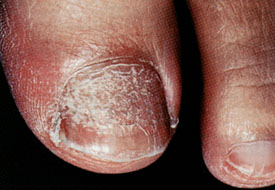
Am Fam Physician. 1998;57(1):119-120
A 38-year-old man presented with thick, whitish, adherent scales and pitting on the surface of the great toenail of the left foot. The abnormality started at the lunula approximately one year ago, had been slowly progressing distally and had extended about three quarters of the way along the nail, with a clear demarcation point between the normal nail and the dystrophic region (see the accompanying figure).

Question
Discussion
The answer is A: psoriasis. This patient has subacute onset of toenail psoriasis,1 not common distal subungual onychomycosis or other fungal nail infection. The photograph shows that the adjacent nails have not yet been involved. The patient had similar signs on the fingernails, but they had been completely transformed since fingernails grow at a much faster rate than do toenails. Demarcation is clearly seen on the toenail, but only after the disease had been present for one year.
Darier's disease is an uncommon disorder of keratinization and may manifest as white streaks along the nail, but the streaks would be linear in a proximal to distal manner. In addition, patients with Darier's disease would have a perifollicular eruption with scale formation on other skin areas. In patients with psoriasis, the nail pits are randomly distributed and represent areas of thickening of the rete pegs in the dermis under the nail matrix; consequently, patients have abnormal nail formation that varies over time. Trauma is a reasonable possibility, but a history of trauma would normally be elicited, and pitting would not be seen.
A patient with lichen planus would also not have pitting but might have longitudinal ridging of the nails. Lichen planus usually is associated with characteristic polygonal violaceous plaques found on other areas of the skin.